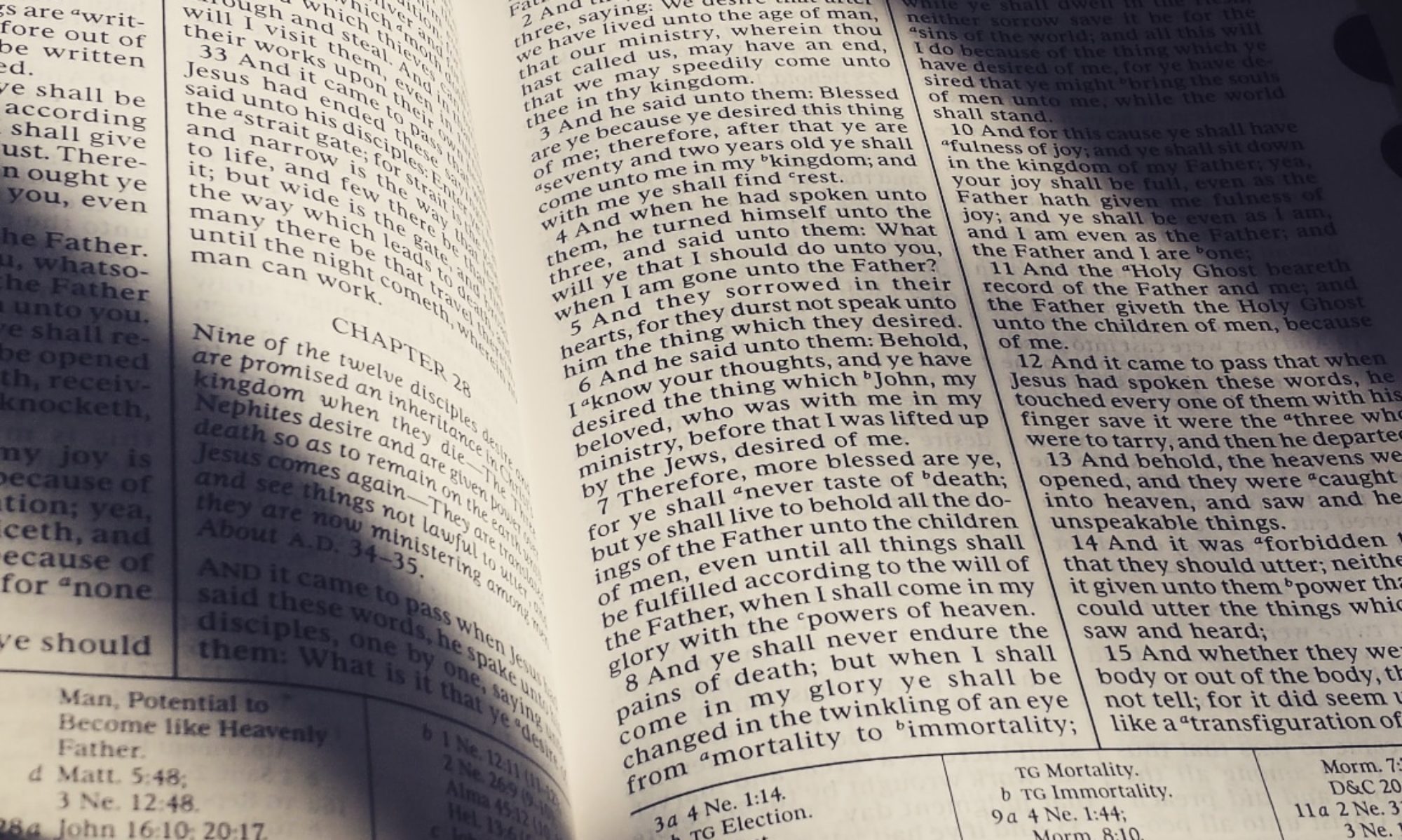Below is a paper I wrote in university, at the age of 18 in 2008. Though some points in it I have been able to clarify to fuller lucidity than is presented in this paper, and some parts are a little incorrect, I want to share this paper with you now intact, as it was, as an insight in to the mind of the young Lex White, a freshman at the University of Nevada, Reno, studying Archaeology and History, with minors in Medieval and Renaissance Studies and Religious Studies:
Research Paper First Draft
By Alexander White
Eng 102.012
It is deeply human to yearn for the knowledge of our creation, to wish to know the forces, processes, and powers by which our universe took shape. Both sciences and religions alike spring up around this most fundamental goal of understanding who we are and our place in the universe, often coming to vastly different conclusions. With such diverse and seemingly irreconcilable differences, I, like many others, came to doubt that the views of religions and sciences could ever be brought in to line with one another, since it is even difficult to bring their views in to line with themselves. Despite my doubts, I have always had a small voice that would tell me that a conclusion reached by religion or by science alone, without the presence of the other, could never be a fully satisfying one. As time went on and my studies in to both religion and science intensified, what I once saw as irreconcilable differences began to appear, well… not so irreconcilable after all, and so it became my pursuit to explain what it was I was just starting to see. The logical beginning point was, of course, the beginning, and thus:
“In the beginning, God created Heaven and the Earth.” This familiar first line of Genesis is one that is often and rather easily discarded as having no scientific value whatsoever. But, as we shall soon see, the creation stories of the book of Genesis clearly follow a numerical order and seem to imply a series of rather simple geometric progressions that we can even find at the base of religious architecture, symbolism, and tradition. And so, intrigued, I ask: are these progressions and the stories themselves metaphors that can somehow be related to modern scientific views of the creation of the universe?
Though a complex question that is difficult to quickly explain, by breaking it down in to its logical steps it should prove relatively simple to explore. Perhaps the most important thing to keep in mind before going further is that we are dealing with biblical verses. The fact is that for most of us, our biblical learning, if existent at all, is based on the ideas within any of several popular translations of the
Bible, which are not necessarily in line with the original Hebrew or Aramaic texts, and so it is important for us to interpret Genesis with the original linguistic context intact. Another important note is that because the cultural root of the Book of Genesis lies in Judaism, I have chosen to analyze it through the lens of Jewish tradition, which can result in vastly different readings of Genesis than those of many modern Christians.
Throughout Genesis, the word translated as God is Elohim, which is, in fact, not a word traditionally used to describe the concept of God in its entirety. While it is a “name of God,” the names of God are used, in Judaism, to understand only one facet of the Divine Nature. Thus, Elohim (notably a plural word) is a term used to describe the forces of creation, almost always referring to the power of division and definition as they act upon the universe, and not God as a whole (which is usually referred to as Ain Sof, translating as “the Infinite”). With this piece of knowledge we can already begin rethinking the first line of Genesis, which we can more conceptually translate as, “In the beginning, through the forces of creation (Elohim) were separated Heaven and the Earth.”
It is here that roots of this numerical sequence lie. First, Genesis begins with the concept of zero, a blank page, full of infinite potential and energy: “In the beginning.” Zero is the place before action, before time, before sequence and space, the place that we can only conceptually understand, and can be thought of as the space that existed prior to the big bang. This primordial chaos is described in many different ways in many different places, and it is usually simply acknowledged as being simply beyond human understanding to define or intellectualize, though I suppose you could try, if you were looking for quite a headache.
From this space of infinite potential, comes the spark of creation, Elohim, one: “In the beginning, God.” This would be the point that existed prior to the big bang, the very beginning of formation. At this time, in the big bang theory, the entire universe existed at one point, as of yet undefined, but still
representing the absolute potential of definition. Suitably, by employing the analogy of zero as the blank sheet, this number one would be a simple point or circle on that sheet (figure 1). It isn’t really important whether we use a point or a circle, because at this point there is simply no concept of space or distance, and so the two figures are for all intents and purposes identical.
figure 1
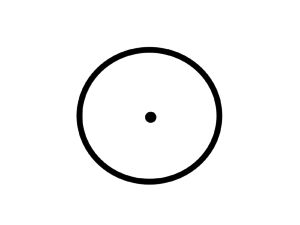
Following a natural numerical order, we arrive at two, completing the first line of Genesis, “In the beginning, God created Heaven and the Earth.” This number two is represented by Heaven and the Earth. At first, this sounds rather silly, as the creation of Earth and the sky can’t have come until much later if we are following a logical linear progression. But as one of the later steps in the creation of Genesis is the creation of the Firmament (of stars) we find that these concepts are wider than one might originally infer from the translation. Rather than being the earth and sky, Earth and Heaven represent being and non-being, respectively. If everything is one, then what must happen before creation? There must be a concept of space, of is and is not, before any particular thing is created. At this stage, the roots of the expansion of the big bang appear in the ability of this single point to begin to divide itself. Here is the first division, the beginning of separation, but still lacking in any particular form whatsoever. At this point, we merely have these two formless halves of one single whole and so the next line of Genesis follows: “And the Earth was without form, and void…”
We can represent this stage by the addition of a second point, or circle. These two points logically make a line, but it is interesting to note that if we draw two circles, each having its center at one of the two points, and the outer edge of its circumference at the opposite point, we have created the religiously significant and prolific geometric figure known as vesica piscis (figure 2). With the addition of a single other point at either of the intersections of the two circles, we can create a perfectly equilateral triangle (figure 3). This additional point is the first concept of real expansion and space, as with the creation of a triangle we have the simplest of polygons, thus the creation of dimension.
figure 2
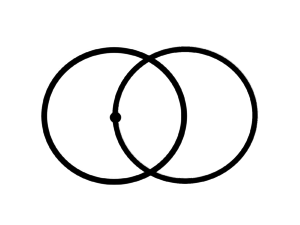
figure 3
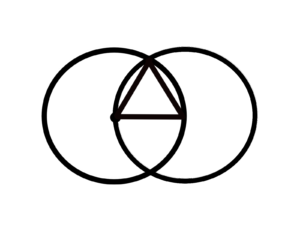
Genesis continues: “And God said, Let there be Light.” Just as Heaven and Earth are representative symbols of something greater than simply the planet we live on and the space around it, the concept of light is not merely the concept of light, but the more fundamental concept of energy. In this case, light is poetically symbolic of more than simply energy, but also of the bright “explosion” of creative expansion. But why is the concept of energy the beginning of dimension? The two forces of Heaven and Earth exist in perfect balance with one another on their own (something that we can observe, by noting that things that exist do not simply stop existing, but merely change forms, and that the space that exists between things does not simply become new things), and so need a third force to act as a catalyst, to actuate creation and set things in to motion. Simply by observing what is around us, we can see that this great actuator of the universe is energy.
Genesis continues soon after with the line, “and God divided the light from the darkness,” showing the differentiation between matter and energy. As energy and matter become separate, the necessary things for physical creation are suddenly available, providing the most basic components of our universe. With the addition of energy to the unified point of being and non-being, there comes the process of sudden expansion as matter is suddenly forced in to motion, pushing outward and expanding outward, mimicked exactly by its counterpart, space.
And as we have the beginning of the creation of the physical universe, Genesis continues, expanding on the advent of light and darkness: “And there was evening, and there was morning—the first day.” At this point in the discussion, it seems strange to even consider that this “day” being referenced is at all analogous to a rotation of the planet Earth. At this point in creation, we don’t even have stars! How can there be night and day? In the same manner as we considered the metaphorical meaning of the text before, it is important for us to regard this cycle of day and night in a similar manner. The day that is
mentioned can have no bearing on what we would normally conceive as day; instead, it must represent an even more holistic idea: the idea that reality proceeds as a series of cycles.
This cycle is encapsulated perfectly in the letters YHVH, traditionally thought of as another name of God, from which we get such names as Jehovah and Yahweh. However, this name of God is supposedly the very word spoken by God in order to create the universe, and thus has seen a great deal of controversy over its proper pronunciation (traditionally, written Hebrew uses no vowels). Many traditional Jews, however, hold that YHVH is, in truth, intended to be unpronounceable. Why is this inability to vocally articulate the word important? The letters of YHVH are pronounced by themselves as “yud,” “heh,” “vav”, and “heh.” Through a little contemplation on the sounds themselves, they begin to seem strangely familiar, and with a little time it becomes apparent why: “yud” is a beginning, with a heavy sound like a bang, or a sharp intake of air, whereas “heh” is the sound of exhalation, “vav” the sound of inhalation, finally concluding in “heh,” another exhalation. This “word” that created the universe represents the cycle of breathing, and therefore one of the most important principles of creation. Like the concepts we have found before it, the true value of YHVH is in its metaphorical value. The universe was created on the basis of the concept of coming and going, waxing and waning, life and death; this is a piece of philosophical wisdom shared by peoples and religions all over the world.
Recalling our main progression, infinity was first gathered to a single point, and then expanded outward as a great exhalation, thus marking the first day. This exhalation cannot continue forever unchanged without forsaking this cyclical concept, and so next must come a returning, another inhalation, a settling of what has been expanded. Note that this does not mean that the universe must stop expanding, as the expansion itself is a constant growth, merely that what was already expanded cannot remain in the primordial state it began in. The settling of this stellar mass and energy in to stars and the first conglomerations of astronomical formation follow as this proto-matter begins to separate,
spread out, settle, and solidify in form. Thus we come to the next step of the creation of Genesis, “And God said, let there be a firmament.”
This fourth point can be drawn in our figure at the midway point of the base of the equilateral triangle, separating it into two equal halves and creating, by modest rearrangement, a square, said to be the foundation of the universe (figure 4). Coincidentally, YHVH is four letters long, so it is possible to have each letter representing a corner of this square. Notable, while four letters long, YHVH is still only made up of three separate letters. Thus, the fourth point is not the addition of a new material for the universe to be built from but the creation of a sturdy foundation from the basic materials of space, matter, and energy. “And there was evening and there was morning, a second day,” continues Genesis, showing that this fourth point represents a whole cycle of creation rather than just a settling. It must be, then, a settling followed by a creative expansion, providing for the next cycle’s settling, and thus the next stage of creation.
figure 4
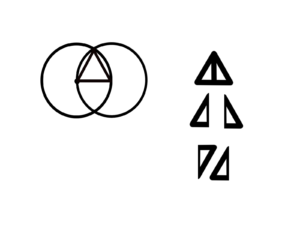
This new cycle of settling comes in the form of planets, and other non-stellar celestial bodies. “And God said, Let the waters under the heaven be gathered together unto one place, and let the dry land appear.” Here we find the symbol of the waters, a recurring symbol throughout Genesis, and a rather complex concept that exists prior to even physical creation. Though there are several possibilities of what the waters refer to, with the most common and simplistic lying in its conception as literal seas, ranging to calling it some sort of metaphysical fabric that is utilized by God. It is at this particular verse, however, that it is possible to begin to find some clues as to what it may be referring to. Most particular of which is the metaphor of the receding of waters to create land; as this concept of waters is used very early on, in Genesis 1:2 (just after the creation of Heaven and Earth) as, “and the spirit of God hovered over the face of the waters,” it becomes a possibility that this term “waters” is used to refer to the primordial state of matter (which makes particular sense, because the waters “under the heaven,” or rather, existing within space, are gathered), which in this case would be infinitely malleable, like water, until it was “gathered” and made in to a solid form. This could very well be analogous, in our particular paradigm, to the astronomic process of the gathering of small rocks, dust, and gases to create planets.
This new stage of creation brings with it, of course, a fifth point to our figure. This addition, if placed directly above the center of the square, creates a pyramid, our first three-dimensional figure (figure 5). Notably, this one point addition to the square base, by nature of connection to each of the four corners, creates four individual triangles, showing, perhaps, the rapidly expanding complexity of creation. It has been said in traditional Judeo-Christian symbolism that five is the number of man. Though at this stage man has not yet been created, this tradition of religious symbolism tends to be full of references of purely numerological significance. Since this fifth point creates a three-dimensional object, and man perceives reality primarily in the three dimensions of space, it could be said that this is the level that the mind of man operates on. In addition to this consequence of dimensional perception, the fifth saying of God creates dry land, or as we have analyzed, planets. This is symbolic of the final “dimension” or physical space required for the creation of life (a planet, in this case) as well as symbolic of the completion of the physical continuum.
figure 5

Before moving to the next two sets of numbers, it is necessary to skip ahead to gain a necessary perspective on the larger picture. At the end of this logical line is the number 10, which is geometrically represented by a figure known as the Tree of Life (figure 6). It is quite clear that the Tree of Life is made up by the connections between ten points; each of the ten points refers, as you may have noticed, to one of the “sayings” of God that led to the creation of something. Besides this, each of the ten points is connected to the others by 22 lines, which are each represented in the first chapter of Genesis by 22 other lines including God. This figure is often said to represent Elohim, and each of the ten points are traditionally named according to a particular aspect of creation. The Tree of Life is constructed
geometrically in a rather significant way: it is what is known as a five-dimensional hypercube (a penteract), an analog to the three-dimensional cube, but existing instead in five dimensions. A five-dimensional hypercube is a figure that has 32 vertices, creating 10 individual “hypercells” (or four-dimensional parts).
So, if this is the final geometric form that we will come to, and we have only arrived at three dimensions so far, what are these final two dimensions? The fourth dimension is clearly time, from a scientific perspective. The fifth dimension is less clear, but in traditional Judaism it has been referred to as “spirit,” representing the spiritual continuum of such concepts as good and evil. Each of these dimensions is marked at either end, as a continuous axis, by the numerical pairs that are to follow: six-seven, and eight-nine. The individual connections that these numbers have to the text of Genesis, however, is a little less clear, and thus the explanations are a little more tenuous than those before, and serve more as a framework to further understanding rather than polished wholes.
It could be said that actual time was irrelevant before life existed to provide progress with which to measure it by. Though there was sequence, there was not a substantial forward development that is necessary for the concept of time, especially given that the amount of time that existed prior to this stage is not even vaguely comprehensible. “And God said, Let the earth put forth grass, herb yielding seed, and fruit-tree bearing fruit after its kind, wherein is the seed thereof, upon the earth,” could thus represent the beginning of the axis of time, as it is the first developments of life, a process that is wholly bound by time. However, this line is also more obviously demonstrating the roots of life, which is a rather difficult concept to understand when we consider that the seventh point and counterpart to this sixth point is the creation of luminaries (the sun and moon), because the sun would be required for the creation of plants in the first place. This could be most obviously understood (within this paradigm) in one of two ways. Either the Bible is claiming that the creation of life happened prior to the creation of
our solar system (which has been scientifically theorized numerous times, but can be quite the logical leap in this case), or the creation of the luminaries and of plants both are much more symbolic steps than they are tangible sequences. The latter of which seems to be the most supported by the considerations made so far.
“And God said, Let there be lights in the firmament of the heaven to divide the day from the night; and let them be for signs, and for seasons, and for days and years.” Here we see clearly the implication that the luminaries provide for the definition of time, giving us the grounds for considering the symbolism of this step. However, there is a strange inconsistency here: why are night and day separated again? We know that this was already done earlier in Genesis, but if we regard the earlier creation as the creation of cycles, and this creation as the literal creation of night and day (or the slightly more symbolic creation of specific time) then this line becomes clarified. The luminaries are the method by which ancient man told time, using both moon and sun to reckon days, months, years, and seasons. Since we can see the beginning of life as the beginning of the relevance of time, it is possible to understand the creation of the luminaries as the setting in motion of the cycles of the procession of time.
Since we find the creation of time before the creation of creatures, I am willing to make the rather religiously controversial argument that time was a necessity to the creation of life, given the procession of events in Genesis, paving the way for the possibility of evolution as a biblically supported method of creation. (As a side note, it is also supported by the fact that evolution is reflective of the cycle of creation that has been laid down above, that is, beginning from a single spark and expanding in to uncountable variation.) “And God said, Let the waters swarm with swarms of living creatures, and let fowl fly above the earth in the open firmament of heaven,” demonstrates life beginning in the water, which is strongly believed to be true by evolutionary biologists. Unfortunately for this snippet of
convenient congruence, it is followed directly by the creation of fowl, which is definitely not the order in which biologists believe the evolution of creatures proceeded.
However, this step is also representative of the creation of the axis of “spirit” as referenced in later books of the bible. Since water-dwelling creatures are by our reckoning the “lowest” and birds that fly are similarly the “highest,” perhaps a continuum of two extremes is being formed by this verse, to be filled in by all things in between in the line and step of creation that follows: “And God said, Let the earth bring forth the living creature after its kind, cattle, and creeping thing, and beast of the earth after its kind.” As these creatures are created, we see both the spiritual middle ground filled in symbolically, as well as the evolutionary foundation for the creation of humankind laid down.
Now that the stage has been set, the tenth point of creation comes as possibly the most interesting one: “And God said, Let us make man in our image, after our likeness.” I was always, personally, baffled by the claim that humans could even be remotely made in the image of God. It violates my very understanding of God, that God could have a physical form to begin with. As it so happens, this is a view shared by the Jews who wrote Genesis, and thus is the key to this conundrum. As we recall, the word used in Genesis in the place of the concept of absolute God is Elohim, or the forces of creation, which is represented by the geometric figure the Tree of Life. Genesis continues: “And God created man in His own image, in the image of God He created them; male and female He created them.” By looking at the original Hebrew of this line, it becomes clear that God created mankind as a whole, with male and female created at the same time. An interesting pattern emerges in this line, as first we have one whole, mankind, which is then divided in to two, male and female, reflecting Elohim and Heaven and Earth at the beginning of Genesis. The next line continues this pattern by blessing humans and bidding them to be fruitful and multiply. This multiplication is not representative of only sexual reproduction, but the continuing of the cycle of one to ten within humans.
The continuation of this cycle makes beginning to see the connection of humans and the image of Elohim as one in the same rather easy. A few other points of interest regarding the Tree of Life and Elohim exist, however. One of which is that the tree of life has 32 vertices. The human body has 31 pairs of nerves spreading in to the body from the spine, with a thirty-second nerve complex in the skull. Another of which is that humans have six major body parts (two arms, two legs, torso, and head), analog to the six “days” of creation, and a spirit, analog to the seventh, resting day. Thus, we can see mankind as a smaller reflection of the forces of creation as a whole, demonstrating the truth behind the geometrical figure of the Tree of Life: it is infinitely repeatable.
It is said that the Tree of Life has its roots in the infinitely small, and has its branches stretching out to the infinitely large. This infinite repetition from small to large is what is known geometrically as a fractal pattern, a seemingly random and chaotic pattern that in truth has a much greater overlying order. These patterns form the basis for the branching of trees, the formation of clouds, the structure of snow flakes, blood vessels, crystals, and patterns in natural processes such as the flooding of the Nile river to the process of evolution. From such simplistic geometrical roots as the circle and triangle we come to such astounding variations in creation through the vast diversity of fractal geometry, and a most harmonious image of the world begins to appear. However, we must return to the original question: does Genesis imply these processes? From one point of view, we can say definitely yes, as they can be related to Genesis at all, and, if nothing else, Genesis was written based on the every-day interaction with these processes by common people. While the origins of Genesis may be more profound than this, it is very easy to be skeptical of such a thing.
Regardless of the profundity of Genesis and whether or not attempts by the religious or the scientific to explain the origins of the universe and its laws ever succeed, the mere contemplation and consideration of these founding forms of the world we live in serves to expand us both mentally and
spiritually. Here, we have briefly examined some possible relations between scientific and religious conceptions of the creation of the universe, and while I have often been unsure of the total validity of the findings that are written about here, I have never been unsure of the value of seeking out such answers. If there is one thing that scientists and mystics alike can agree on, it is that the world is a profound and beautiful place. It is from the root of this singular thought that we can trace all manner of religious discourse and scientific inquiry. And so, it is human nature to seek this knowledge greater than ourselves, just as it is human nature for us to squabble over it, but we continue in the hopes that one day through our endeavors, only universal truth will remain.
Bibliography
Brettler, Marc Zvi. How to Read the Jewish Bible. New York: Oxford, 2007.
Carr, Paul H. “Does God Play Dice? Insights from the Fractal Geometry of Nature.”
Zygon: Journal of Religion & Science 39 (2004): 933-940.
Cooper, David A. God is a Verb: Kabbalah and the Practice of Mystical Judaism. New York: Riverhead,
1997.
Jones, Charles Stansfeld. The Anatomy of the Body of God. San Francisco: Red Wheel/Weiser, 1973.
Kaplan, Aryeh. Sefer Yetzirah: The Book of Creation in Theory and Practice. Revised ed.
San Francisco: Red Wheel/Weiser, 1997.
Pannenburg, Wolfhart. “Eternity, Time, and Space.” Zygon: Journal of Religion & Science 40 (2005): 97-106.
Raju, C.K. “Religious Roots of Mathematics.” Theory, Culture & Society 23 (2006): 95-99.
